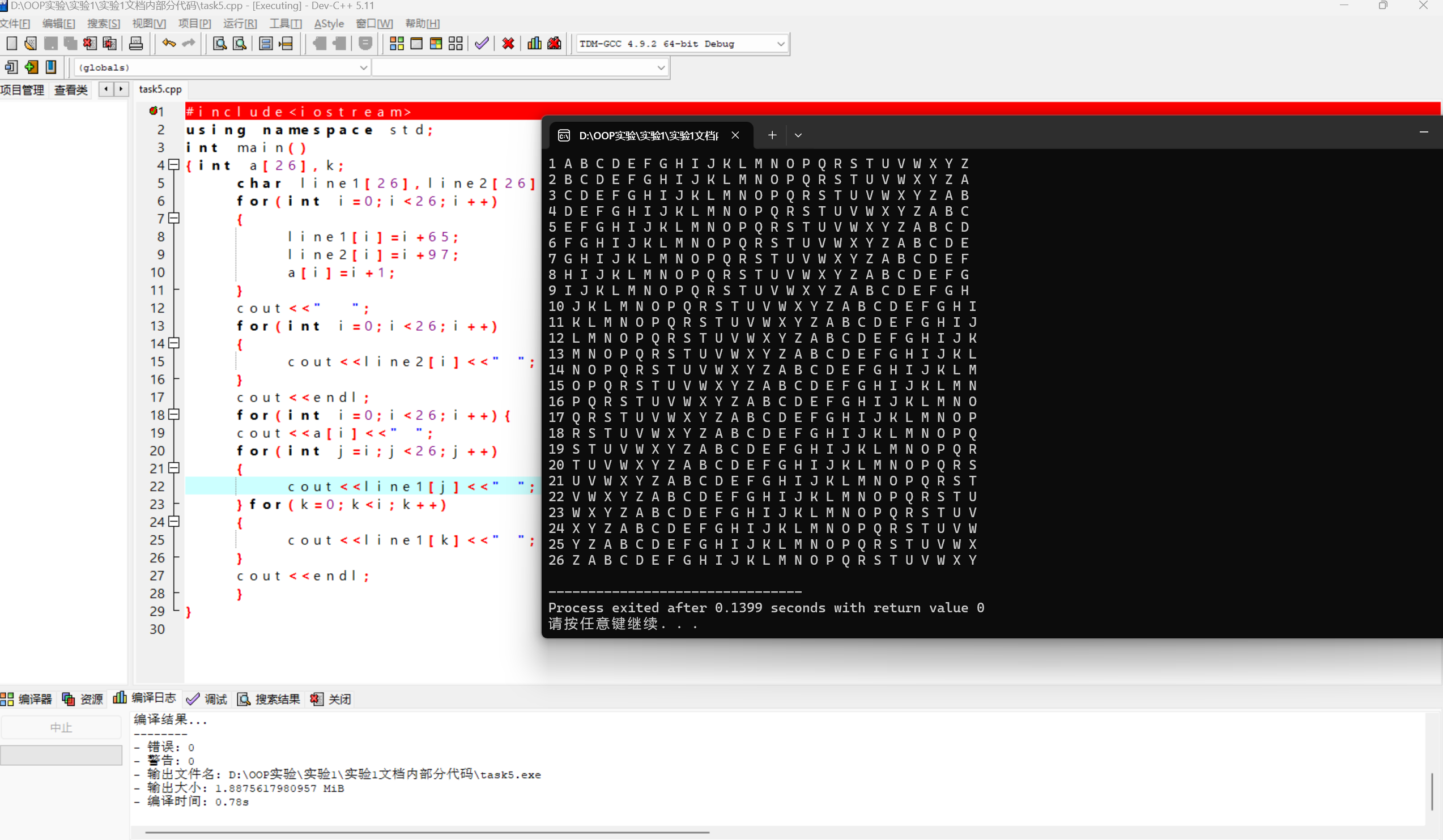任务1
源代码task1.cpp
// 本例用到以下内容:
// 1. 字符串string, 动态数组容器类vector、迭代器
// 2. 算法库:反转元素次序、旋转元素
// 3. 函数模板、const引用作为形参
#include <iostream>
#include <string>
#include <vector>
#include <algorithm>
using namespace std;
// 声明
// 模板函数声明
template<typename T>
void output(const T &c);
// 普通函数声明
void test1();
void test2();
void test3();
int main() {
cout << "测试1: \n";
test1();
cout << "\n测试2: \n";
test2();
cout << "\n测试3: \n";
test3();
}
// 函数实现
// 输出容器对象c中的元素
template <typename T>
void output(const T &c) {
for(auto &i: c)
cout << i << " ";
cout << endl;
}
// 测试1
// 组合使用算法库、迭代器、string反转字符串
void test1() {
string s0{"0123456789"};
cout << "s0 = " << s0 << endl;
string s1{s0};
reverse(s1.begin(), s1.end()); // 反转指定迭代器区间的元素
cout << "s1 = " << s1 << endl;
string s2{s0};
reverse_copy(s0.begin(), s0.end(), s2.begin()); // 将指定迭代区间的元素拷贝到指定迭代器开始的目标区间,并且在复制过程中反转次序
cout << "s2 = " << s2 << endl;
}
// 测试2
// 组合使用算法库、迭代器、vector反转动态数组对象vector内数据
void test2() {
vector<int> v0{2, 0, 4, 9};
cout << "v0: ";
output(v0);
vector<int> v1{v0};
reverse(v1.begin(), v1.end());
cout << "v1: ";
output(v1);
vector<int> v2{v0};
reverse_copy(v0.begin(), v0.end(), v2.begin());
cout << "v2: ";
output(v2);
}
// 测试3
// 组合使用算法库、迭代器、vector实现元素旋转移位
void test3() {
vector<int> v0{0, 1, 2, 3, 4, 5, 6, 7, 8, 9};
cout << "v0: ";
output(v0);
vector<int> v1{v0};
rotate(v1.begin(), v1.begin()+1, v1.end()); // 旋转指定迭代器区间[v1.begin(), v1.end())之间的数据项,旋转后从迭代器v1.begin()+1位置的数据项开始
cout << "v1: ";
output(v1);
vector<int> v2{v0};
rotate(v2.begin(), v2.begin()+2, v2.end());
cout << "v2: ";
output(v2);
vector<int> v3{v0};
rotate(v3.begin(), v3.end()-1, v3.end());
cout << "v3: ";
output(v3);
vector<int> v4{v0};
rotate(v4.begin(), v4.end()-2, v4.end());
cout << "v4: ";
output(v4);
}
运行结果截图
!实验结果截图
任务2
task2.cpp
#include <iostream>
#include <vector>
#include <string>
#include <algorithm>
#include <numeric>
#include <iomanip>
using namespace std;
// 函数声明
// 模板函数声明
template<typename T>
void output(const T &c);
// 普通函数声明
int rand_int_100();
void test1();
void test2();
int main() {
cout << "测试1: \n";
test1();
cout << "\n测试2: \n";
test2();
}
// 函数实现
// 输出容器对象c中的元素
template <typename T>
void output(const T &c) {
for(auto &i: c)
cout << i << " ";
cout << endl;
}
// 返回[0, 100]区间内的一个随机整数
int rand_int_100() {
return rand() % 101;
}
// 测试1
// 对容器类对象指定迭代器区间进行赋值、排序
void test1() {
vector<int> v0(10); // 创建一个动态数组对象v0, 对象大小为10
generate(v0.begin(), v0.end(), rand_int_100); // 产生[0, 100]之间的随机整数赋值给指定迭代器区间[v0.begin(), v0.end())内的每个数据项
cout << "v0: ";
output(v0);
vector<int> v1{v0};
sort(v1.begin(), v1.end()); // 对指定迭代器区间[v1.begin(), v1.end())内数据项进行升序排序
cout << "v1: ";
output(v1);
vector<int> v2{v0};
sort(v2.begin()+1, v2.end()-1); // 对指定迭代器区间[v1.begin()+1, v1.end()-1)内数据项进行升序排序
cout << "v2: ";
output(v2);
}
// 测试2
// 对容器类对象指定迭代器区间进行赋值、计算最大值/最小值/均值
void test2() {
vector<int> v0(10);
generate(v0.begin(), v0.end(), rand_int_100);
cout << "v0: ";
output(v0);
auto iter1 = min_element(v0.begin(), v0.end());
cout << "最小值: " << *iter1 << endl;
auto iter2 = max_element(v0.begin(), v0.end());
cout << "最大值: " << *iter2 << endl;
auto ans = minmax_element(v0.begin(), v0.end());
cout << "最小值: " << *(ans.first) << endl;
cout << "最大值: " << *(ans.second) << endl;
double avg1 = accumulate(v0.begin(), v0.end(), 0)/v0.size();
cout << "均值: " << fixed << setprecision(2) << avg1 << endl;
cout << endl;
vector<int> v1{v0};
cout << "v0: ";
output(v0);
sort(v1.begin(), v1.end());
double avg2 = accumulate(v1.begin()+1, v1.end()-1, 0)/(v1.size()-2);
cout << "去掉最大值、最小值之后,均值: " << avg2 << endl;
}
运行结果截图
!实验2截图
实验3
task3.cpp
#include <iostream>
#include <string>
#include <algorithm>
bool is_palindrome(std::string s);
int main() {
using namespace std;
string s;
while(cin >> s) // 多组输入,直到按下Ctrl+Z后结束测试
cout << boolalpha << is_palindrome(s) << endl;
}
bool is_palindrome(std::string s){
std::transform(s.begin(),s.end(),s.begin(),::tolower);
int l=0;
int r=s.size()-1;
while(l<r){
if(s[l]!=s[r]){
return false;
}
l++;
r--;
}
return true;
}
实验3截图
!实验3截图
实验4
task4.cpp
#include <iostream>
#include <string>
#include <algorithm>
std::string dec2n(int x, int n = 2);
int main() {
using namespace std;
int x;
while(cin >> x) {
cout << "十进制: " << x << endl;
cout << "二进制: " << dec2n(x) << endl;
cout << "八进制: " << dec2n(x, 8) << endl;
cout << "十六进制: " << dec2n(x, 16) << endl << endl;
}
}
std::string dec2n(int x, int n) {
const char digits[] = "0123456789ABCDE";
std::string result;
if(x==0){
return "0";
}
bool isNegative=false;
if(x<0){
isNegative=true;
x=-x;
}
while(x>0){
result+=digits[x%n];
x/=n;
}
if(isNegative){
result+="-";
}
std::reverse(result.begin(),result.end());
return result; }
实验4结果截图
!实验4结果截图
实验5
task5.cpp
#include<iostream>
using namespace std;
int main()
{int a[26],k;
char line1[26],line2[26];
for(int i=0;i<26;i++)
{
line1[i]=i+65;
line2[i]=i+97;
a[i]=i+1;
}
cout<<" ";
for(int i=0;i<26;i++)
{
cout<<line2[i]<<" ";
}
cout<<endl;
for(int i=0;i<26;i++){
cout<<a[i]<<" ";
for(int j=i;j<26;j++)
{
cout<<line1[j]<<" ";
}for(k=0;k<i;k++)
{
cout<<line1[k]<<" ";
}
cout<<endl;
}
}
实验5截图

实验6
task6.cpp
#include<iostream>
#include<stdlib.h>
#include<time.h>
using namespace std;
int suanfa(int a,int b,int c)
{
if(c==1){
return a+b;
}
else if(c==2){
return a-b;
}
else if(c==3){
return a*b;
}
else if(c==4){
return a/b;
}
}
int main()
{int a[10],b[10],c[10],d[10],zheng=0,t;
srand((unsigned int)time(NULL));
for(int i=0;i<10;i++)
{
a[i]=1+rand()%10;
b[i]=1+rand()%10;
c[i]=1+rand()%4;
}
for(int i=0;i<10;i++)
{
while(c[i]==2&&a[i]<b[i])
{
t=b[i];
b[i]=a[i];
a[i]=t;
}
while(c[i]==4&&a[i]%b[i]!=0)
{
a[i]=rand()%10+1;
b[i]=rand()%10+1;
}
}
for(int i=0;i<10;i++)
{
d[i]=suanfa(a[i],b[i],c[i]);
}
for(int i=0;i<10;i++)
{
cout<<a[i];
if(c[i]==1)cout<<"+";
else if(c[i]==2)cout<<"-";
else if(c[i]==3)cout<<"*";
else if(c[i]==4)cout<<"/";
cout<<b[i]<<"=";
cin>>t;
if(t==d[i])zheng++;
}cout<<"正确率:"<<zheng<<"0.00%"<<endl;
}
实验6截图
实验总结
熟悉C语言基本语法和数据类型。
掌握C语言程序的编写和调试技巧。
培养解决问题的能力。
加深对计算机原理的理解。
提高团队合作和沟通能力。


